In the summer, you can encounter an unpleasant “guest” in the form of a terrible or viper. Especially often you can see reptiles near reservoirs or in a forest belt. Of course, such a meeting does not promise anything pleasant. Fortunately, reptiles do not attack without particular need, but if they so do a threat in your actions, beware. However, unlike vipers, the elaborations are more safe, as they are not poisonous. In today's article, we will describe the main differences between the uns and the viper and tell you how to act if you came across a snake.
Content
- What does the viper look like
- Photo by Teru and Vipers
- Viper and already: similarity
- Differences of Teru and Vipers
- What does the nest look like a terrible and vipers
- What to be afraid of ditches and vipers
- How to get rid of snakes on the site. Video
- First aid for the bite of the vipers and terrible
What does the viper look like
Osten and vipers are the most common snakes of the temperate latitudes of Eurasia. That is why everyone can meet them. Especially the danger in the form of such snakes in wait for travelers, lovers of campsite and outdoor activities. Especially dangerous areas - forest belts and places near reservoirs. The color of the terrible and vipers can help distinguish these types of snakes. However, the differences are not always more significant than similarities. Let's figure it out in detail unnecessarily in the features of uns and viper.
How to recognize Teru
Owls are non -nuclear reptiles. On average, they reach a size of 1 meter. However, there are real "giants" from 1.5 to 2 meters long. The color of the snake is quite diverse. They can be:
- dark gray;
- olive;
- brown;
- black.
Usually the color is not plain: on the body of the snake you can observe dark spots in a checkerboard pattern. The lower part of the body is light gray or dirty white with a dark longitudinal strip in the middle of the abdomen. A distinctive feature of these snakes are two symmetrically located spots on the back of the head. The people are called these spots "ears." The spots are characterized by orange, yellow or dirty white. It is worth noting that water owls or fraud may not have spots at all. This does not mean that you are faced with a poisonous representative, it is just a feature of the subspecies. In this case, a distinguishing feature of the runner can be considered a chess pattern on the “back”.
Already there are no poisonous teeth. The bite of these snakes is more like a shield. Nunes still have teeth. They are located in the middle part of the pharynx and serve for the convenience of swallowing production. As a rule, biting a person, the dinners do not reach these teeth to the soft tissue, and therefore the danger is minimal. However, according to studies, food residues often accumulate in a sip of ugles. Being predators, sniffs often eat fish and rodents. The accumulated food remnants of the food rot, developing a beneficial environment for pathogenic bacteria. For snakes, such an infection is not terrible. But, if during the human bite the pathogenic flora is transferred to the tissues or to the blood of the victim, this is fraught with serious consequences. The place of the bite can become inflamed, suppressed, etc.
You can meet a terrible near reservoirs. These reptiles feed mainly with frogs and fish. Owl of their nests is driven under the roots of trees, in stones or mouse minks.
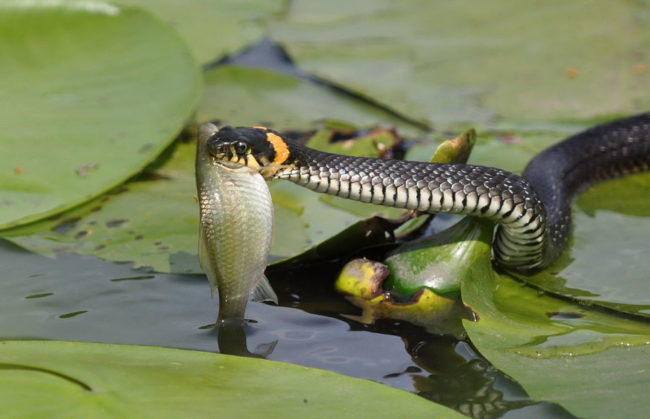
Although already shared are considered quite harmless, as statistics show, they attack many times more often on a person than vipers. These rather aggressive snakes can bite even with the slightest irritation. It is noteworthy that when meeting with a person or any other threat, the moists begin to hiss warning. In addition, these snakes throw smelly bowel movements into their offender. If the measures do not fall, the sniffs bite and instantly hide from the “crime scene”.
In captivity, the elaborations live for a long time and productively. These snakes are easily screwed and adapt to new living conditions.
How to recognize viper
The viper is a small snake. These reptiles reach a length of not more than 50 centimeters, there are subspecies of vipers, which can be from 75 centimeters to 1 meter. But you should not focus on the color: depending on the individual characteristics, it can be from black, gray, brown or brown to purple and even orange. A distinctive feature of the vipers can be called a strip along the back. Usually it has the shape of a zigzag, but it happens with even edges. The strip can be of different colors, but it is always darker than the main background. The body of the vipers is thick, the tail is short, rounded. The face of this snake is triangular.
A characteristic feature of the vipers is a pair of poisonous teeth in the upper part of the pharynx. The poison is located in a thin channel and is thrown out only with a bite. It is noteworthy that the poisonous teeth are very brittle and in the summer they change every six weeks.
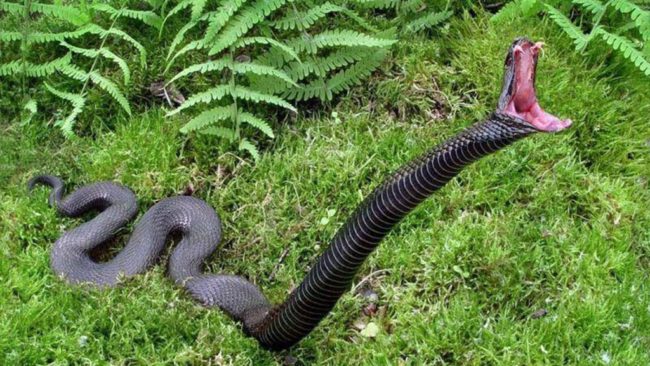
The viper hunts mainly for rodents. Swallowing is carried out only after the sacrifice of the victim. The vipers in forest belts live. The widespread opinion that viper can often be found near water bodies erroneously. These snakes do not like water and try to avoid it in every possible way. Most often, in reservoirs you can find polos or water heights, which resemble a viper for inexperienced eyes. Interestingly, in captivity, the vipers do not live long, refusing food and soon dying.
The vipers are not the most aggressive snakes and attack only in case of serious danger. When meeting with a person, this snake is trying to hide before, and if this fails, he attacks. However, if the viper is tanned, the snake falls into frantic aggression and can apply attacks one after another. There are cases when a viper struggled with a stick, stone or even her own shadow, taking inanimate objects for the offender. The poison of vipers is dangerous for humans. Nevertheless, deaths are extremely rare. In the case of adequate medical care, sad consequences can be avoided. In the risk zone after the bite of the vipers - children, elderly people, people with blood disease.
Photo by Teru and Vipers
What a viper looks like, photo
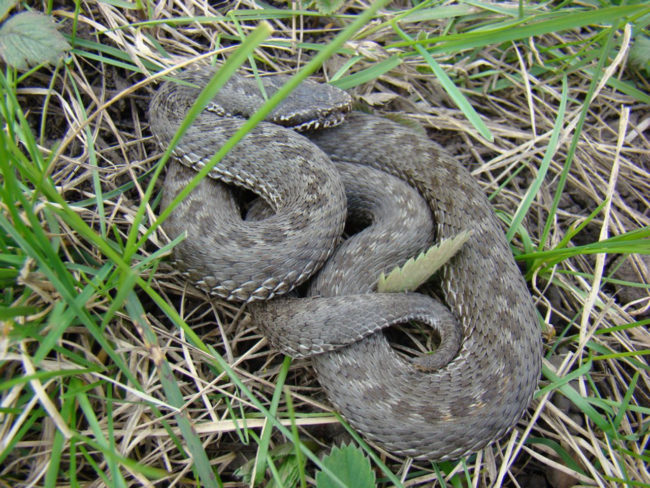
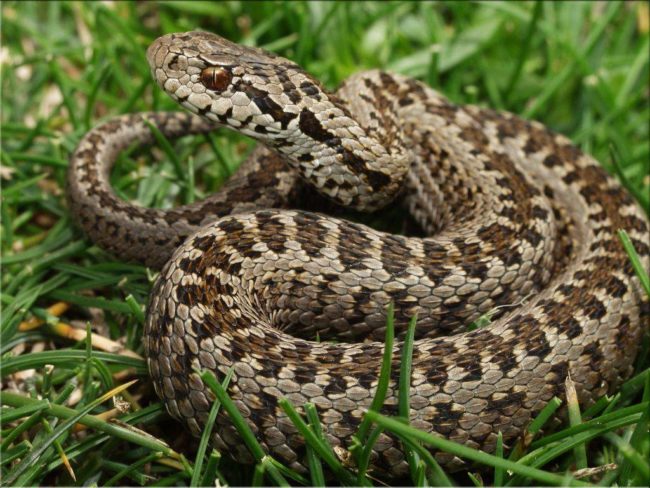
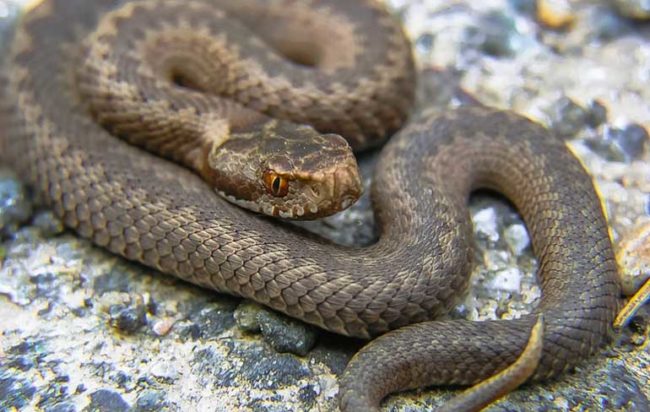
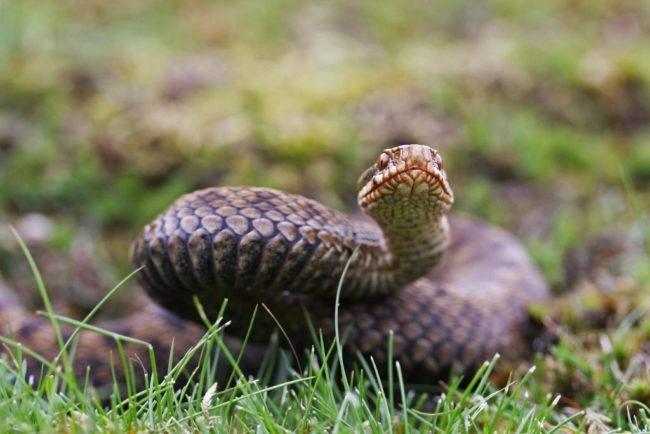
What it looks like, photo



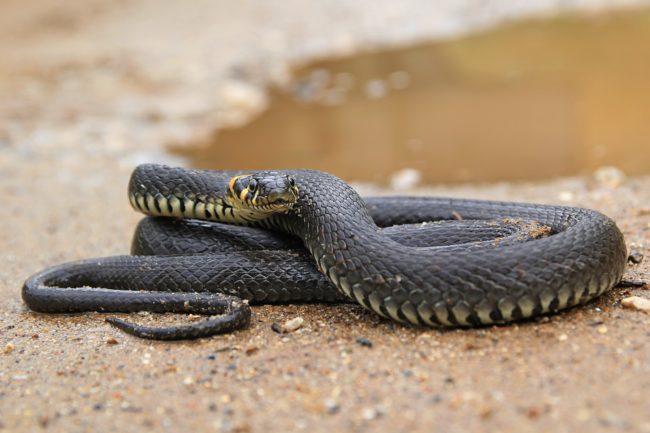
Viper and already: similarity
Vipers and eating have a common habitat. These snakes can be seen in meadows, glades, the banks of rivers or lakes, in thick thickets or abandoned buildings. Egg, unlike vipers, love water very much. I often drink and bathe. Therefore, the uns can be found not only not to the shore, but also in the water.
Both the ostens and vipers like to spend time in the sun, stumps, paths or stone slabs, where the heat transfer of objects is strengthened. The widespread opinion that the dwells and vipers are conflicting among themselves is not entirely true. In nature, you can meet Teru and Viper lying nearby and warming in the sun. Such a society does not interfere with either one or the other.
If you compare the viper and the terrible, one common quality can be noted - they do not attack without a visible threat and try to stay from a person as far as possible. When meeting with a person, snakes are primarily done by warning manipulations: vipers - they raise their heads, hisses and make threatening throws, can pretend to be dead, or take a defensive position - start hissing and emit an unpleasant aroma.

Differences of Teru and Vipers
What is the difference between Viper and Toru? If you read the above information, it is clear that the differences are more than obvious. Let's figure out in detail how to distinguish a terrible from the vipers.
The difference is Torus and the vipers:
- The length of the snakes. Vipers are small snakes that reach a maximum size of 0.75-1 meter. Owls are long, compared to poisonous representatives, and are mainly from 1 to 2 meters.
- The color of the snake. The coloring and uns and viper are quite diverse and is not an indicator. The distinctive features of the snakes are a long, often zigzag strip along the back near the vipers and bright “ears” in the uns. Often you can meet the question: "Black or viper?" It’s not regrettable, but the dark color happens both of the uns and the viper, and if you saw a black snake, it is better to focus not on color, but on other distinctive features.
- The shape of the head. I have an oval head, the vipers are triangular.
- The shape of the body. Owls have a thin elongated body, vipers - a massive body girth and a sophisticated tail.
- Habitat. Owls live mainly near reservoirs, vipers in forest belts.
- Snake teeth. When opening the pharynx at the viper, you can see two characteristic poisonous fangs, there are no visible teeth in the front of the jaw, small fangs can be viewed a little further than the middle of the pharynx. They are in the upper part and serve for the convenience of swallowing food.
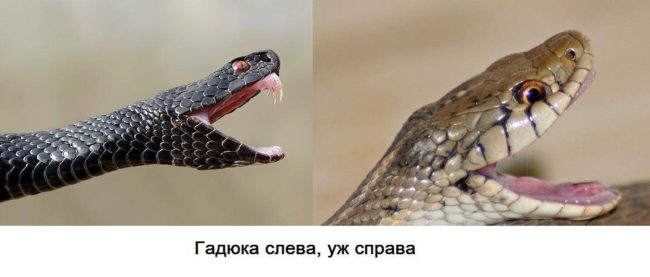
- Owls eat Mostly fish and frogs, vipers - rodents.
- Owls like to swim And often there are in water, vipers do not tolerate water and are in it only in rare cases.
- Vipers do not live in captivity And they die shortly after capture, dull - adapt to captivity and amenable.
The differences in the uns and vipers are quite obvious, however, it is not always possible to adequately evaluate the environment and the appearance of the snake when meeting with reptiles. It is better to avoid places where snakes live.
What does the nest look like a terrible and vipers
The nests of the uns and viper practically do not differ from each other. Snakes equip the “dwelling” in quiet, warm back streets. For example, in a pile of stones, under the gentle branches of trees, in bricks. Owls can also equip mouse holes as a dwelling.
In the spring, you can also meet the masonry of the eggs and vipers. Such nests have their differences.
The eggs are terrible
They mate in the spring, after winter hibernation. One female, depending on age, can lay off from 15 to 100 eggs.
The masonry itself looks quite unusual - the eggs are tightly blind into a single whole and tightly glued to the nest. The thing is that when laying the eggs, they have a soft shell covered with mucus. When dried, the mucus hards, and the eggs stick together with each other and the surface for masonry. In the diameter of the eggs can be of different sizes, depending on the characteristics of the snake. Large owls lay eggs from 1 to 5 centimeters in diameter, small individuals - from 1 to 3 centimeters.
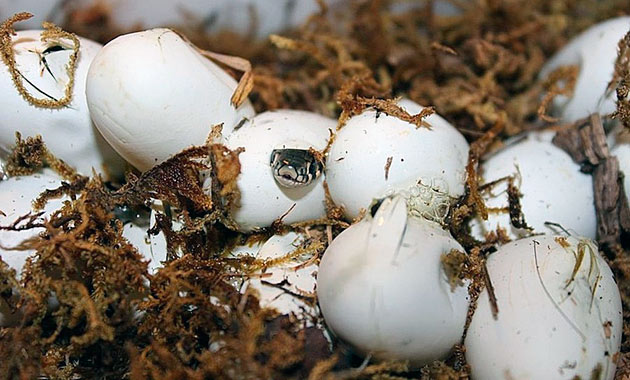
The incubation period lasts 1-2 months. It is noteworthy that incisions can lay masonry and choose time depending on the favorable conditions. So, often embryos begin to form in the body of the female.
The hatching horror breaks the “path” with an egg tooth, which is located on the head. They immediately begin to eat on their own, usual for snaps of food.
Gaduki eggs
Vipers belong to the livestock. This means that the development of eggs and hatching of offspring occurs in the maternal womb. Usually from 8 to 12 cubs is born. During the “birth”, the female wraps the tree so that the tail remains on weight. At the same time, there is a “spread” of the serpentines to the Earth, which from the moment of birth begin an independent life.
Young individuals have the same amount of poison as adults. The poison is identical in composition and consistency. Before the first hibernation, the vipers do not eat to avoid problems with digestion of food. Only when born, the snakes are fed, because they are more aggressive.
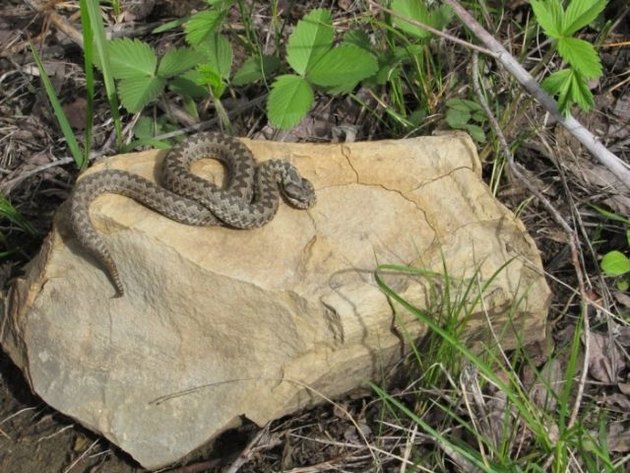
The mating season of Gadyuk-May, the time of birth of the offspring is the end of August and the beginning of September.
What to be afraid of ditches and vipers
If you are in an area where it is highly likely to meet the snake, always look under your feet and track the situation around you. When meeting with viper, slow down in place and do not make sudden movements. The snake will take a defensive pose, but not seeing the threat will hide.
There are not so many fears of Nuni and Gadyuk, but there are stimuli that snakes are trying to avoid in every possible way.
- Fire. Both the ostens and vipers are afraid of fire. Neither the other snake crawls to the fire, if there is no extreme need for this.
- Loud sounds. Loud unnatural monotonous sounds scare snakes. With this account, industrial reputers of reptiles have been developed.
- Perennial smells. Owls and vipers are quite susceptible to smells. They do not tolerate chemical aromas, as well as some natural smells.
- Animal hair. Natural wool will help to scare off the snakes. Lay out it with locks in possible nesting places and over time the snakes will leave this territory.
How to get rid of snakes on the site. Video
First aid for the bite of the vipers and terrible
A poisonous snake can wait for you in the most inappropriate place. Of course, you need to avoid such meetings and fear bites. But if, nevertheless, the snake bit you, first aid is inevitable. You can provide initial manipulation before delivery to the hospital. However, you need to seek medical help anyway to avoid sad consequences.
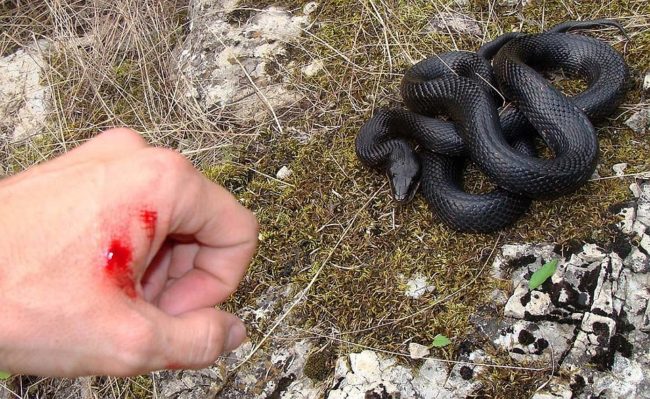
First aid for the bite of the vipers:
- Water. A plentiful drink will help to quickly remove poison from the body and slow down its absorption. You need to drink as much as possible. As drinking, exclusively non -carbonated water without sweeteners is suitable.
- Immobilization. With a bite of vipers, you need to try to move and panic as little as possible. This behavior can cause tachycardia.
- Do not drink tea, coffee and alcohol. These drinks accelerate metabolic processes and blood circulation. Thus, the poison spreads faster through the body. You can’t even treat the wound with alcohol - it dilutes blood and accelerates its current through the veins.
- Do not apply a tourniquet at the bite. Turning the bitten zone can be fraught with stagnation of poison. At the same time, the poison will destroy tissues and cause necrosis.
- Remove the poison from the wound. You can remove the poison from the wound through its suction. The poisonous substance must be spit, but even if you swallow a little poison, it’s not scary, the mucous membrane of the stomach and esophagus is not susceptible to this substance. Before the manipulation, make sure that there is no wound in your mouth, since the poison will enter your circulatory system.
- After removing the poison, process the place of the bite with green or iodine. In no case should the wound with oxidizing substances or hot objects.
- The correct position of the body. After the bite, the victim must lie down so that the head is below the body. This will help to avoid the negative consequences associated with poor blood flow in the brain.
Even if you have successfully produced first aid, the victim must immediately be taken to the hospital. Doctors will prescribe the correct treatment of bitten in order to avoid complications.
With a bite, Teru should also contact a medical institution. There, the wound will be washed and prescribed drugs that help avoid infection of the wound.









Comments
a couple of years ago, there was no side of metrogils from the same problem, there were no side effects ...
I’m not a fan of peeling at all, it saves from acne of metrogil, it also smoothes it ...
Great article! ...
I take the second course of the Capsules Climafite 911. The tides went very quickly. It became calmer, irritability went away and I sleep well ...
i also noticed - it is worth nervous, everything immediately affects the face. Therefore, I try to avoid conflicts and unpleasant people. Of the creams, I like Miaflow from wrinkles - smoothes not only small wrinkles ...